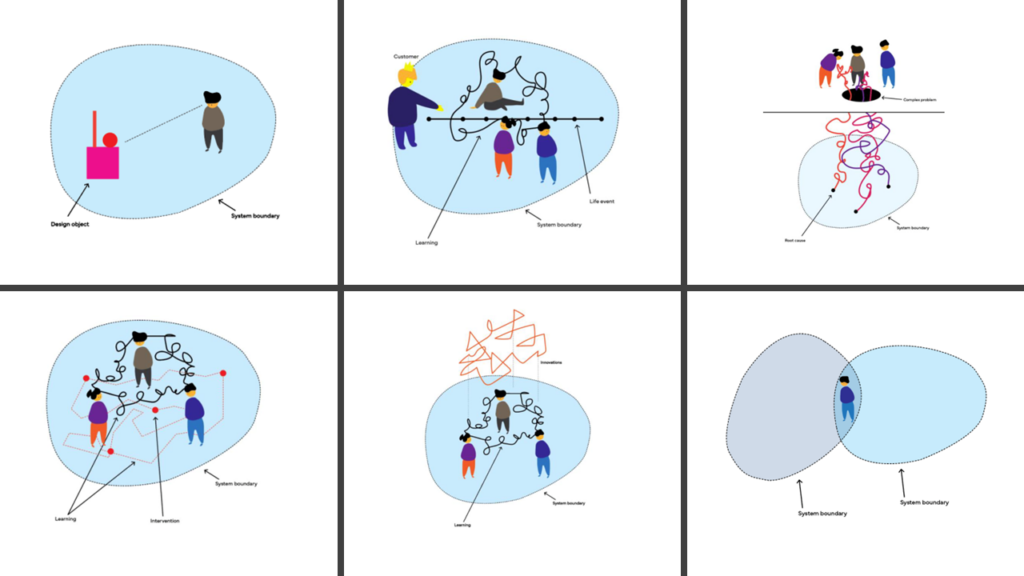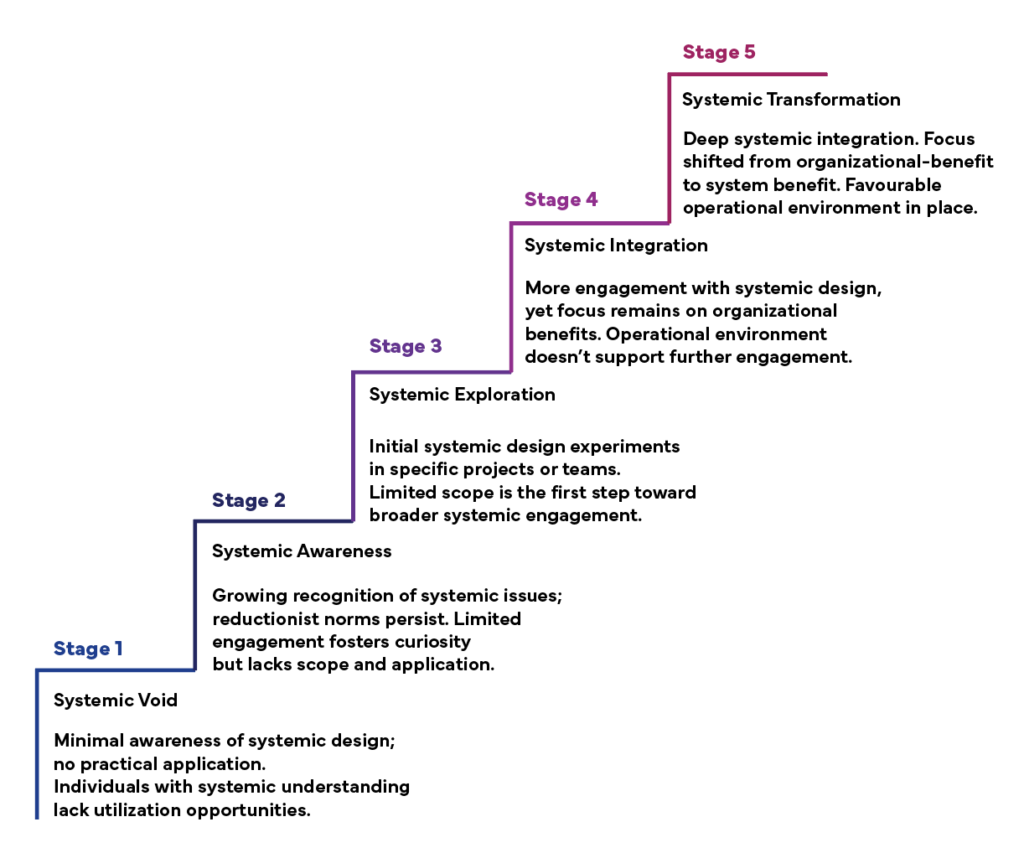Systemic design is an approach for addressing complex issues, yet it often misses the organisational perspective. This article addresses this gap by summarising six perspectives on systemic design and a maturity model developed by Emilia Saarelainen. It also discusses how organisations can better operate by building organisation-wide capabilities in systemic design.
 Picture: bagotaj/Adobe Stock/Education Licence
Picture: bagotaj/Adobe Stock/Education Licence
Emilia Saarelainen’s (2024) thesis titled Exploring Systemic Design: Practical Insights for Organizational Implementation explored the concept of systemic design within organisations. As a practical outcome of this thesis, a guide titled A Little Booklet on Systemic Design was developed to help designers and others to integrate systemic design into their work and organizations. The thesis was part of her studies in Laurea’s Master’s Degree Programme for Service Innovation and Design.
Literature commonly defines systemic design as a blend of systems thinking/approaches and design thinking/approaches aiming to tackle complex, large-scale issues through a holistic and interconnected approach (e.g., Sevaldson and Jones, 2019; Jones and Van Ael, 2022; van der Bijl-Brouwer, 2023). It emphasizes understanding the relationships and interdependencies within a system rather than focusing on isolated problems or components. In the context of organizations, systemic design involves applying this integrated approach to organizational transformation by considering the broader system in which the organization operates, while also accounting for the complexity and unpredictability of such systems. This requires a focus on collaboration, learning, and navigating uncertainty across different levels of the organization. (Saarelainen 2024.)
Implementing Systemic Design in Organisations
However, Saarelainen’s research revealed more nuances to this definition. Through 11 semi-structured interviews with Finnish and international practitioners working on systemic issues—some more design-oriented than others—six different perspectives on systemic design were identified. The six perspectives are listed below and a visual illustration of each of them is seen in Picture 1. (Saarelainen 2024.)
- Systemic design as designing a product or service with a wider system in mind
- Systemic design as designing around customer-focused life events
- Systemic design as addressing complex problems
- Systemic design as a portfolio of interventions
- Systemic design as novelty emerging from interconnectedness
- Systemic design as in-between systems
These perspectives varied in several ways. For instance, the role of the user differed: one perspective focused on customer life events while others extended the focus beyond individual users. Approaches to problems also varied: even though complex problems are often seen as the starting point for systemic design, some perspectives deliberately shifted the focus away from problem-solving to system-level thinking. Additionally, some perspectives advocated for only considering the context of the whole system in relation to the part that is being designed rather than attempting to redesign the entire system.
 Picture 1. The Six Systemic Design Perspectives (Saarelainen 2024).
Picture 1. The Six Systemic Design Perspectives (Saarelainen 2024).
An organisation’s maturity for systemic design varies, as some organisations are more advanced than others in their ability to engage in systemic-level work. To address that, a maturity model for systemic design was developed. The systemic design maturity model outlines five stages: starting from the absence of systemic design (Systemic Void), progressing to initial recognition and curiosity (Systemic Awareness), and then to limited experimentation within specific projects (Systemic Exploration). It advances to broader integration across the organisation with cross-functional collaboration (Systemic Integration), and culminates in a complete transformation where systemic design is deeply embedded and the organisation adopts a system-focused approach (Systemic Transformation). At each stage, the role of learning evolves from individual to team-based and eventually to system-wide. See Picture 2 for a visual illustration of the systemic design maturity model. (Saarelainen 2024.)
 Picture 2. Systemic Design Maturity Model (Saarelainen 2024).
Picture 2. Systemic Design Maturity Model (Saarelainen 2024).
Different systemic design approaches require varying levels of organisational maturity. At the initial stages, organisations can adopt systemic design approaches that align with their existing reductionist way or operating without fundamentally challenging it. For instance, designing products or services with a broader system in mind (Perspective 1) illustrates this approach. In the intermediate stages, more collaboration among multiple actors and a networked approach to organising (Scharmer 2015) are necessary, although the primary focus remains on organisational benefits. For example, designing around customer-focused life events (Perspective 2) requires a relatively advanced level of systemic maturity but primarily emphasizes engagements between organisations rather than systemic-level action. Higher maturity levels are essential for approaches that focus on innovation arising from systemic interconnectedness (Perspective 5), demanding a profound commitment to systemic thinking and acting. These advanced stages involve moving beyond problem-focused thinking and individual stakeholders toward ecosystem co-creation (Scharmer 2015). See picture 3 for a visual illustration of the matrix. (Saarelainen 2024.)
 Picture 3. Matrix of Organisational Maturity and Six Systemic Design Perspectives (Saarelainen 2024).
Picture 3. Matrix of Organisational Maturity and Six Systemic Design Perspectives (Saarelainen 2024).
The findings of the research show that organisations play a key role in systemic design, and often, the obstacles to systemic design originate from within them. However, there appears to be limited literature on the organisational aspects of systemic design, including understanding and addressing these challenges, as well as how to integrate systemic design into organisations.
How could organisations be more systemic – what’s the role of systemic design?
In discussing how organisations can be more systemic, the question extends beyond design. As systemic maturity increases, the focus shifts to how an organisation relates to, operates within, and influences the system. Therefore, the key question is not just how to make design more systemic but how to enable organisations to operate more systemically. While design plays a role, more is required.
In organisations at the lower levels of the systemic design maturity model, design teams might be aware of or exploring ways to operate more systemically. However, when this know-how is limited to individuals or teams, systemic design and its impact might be hindered by the rest of the organisation operating in a different manner. If operating systemically and in a systemic environment is a strategic objective of the organisation, organisations should focus on developing the organisation-wide capabilities that can enable the whole organisation to operate systemically.
The concept of capability is useful when the context of learning is not just an individual or a team but an organisation or organisations. In this case, the goal of learning becomes developing ways for the organisation to renew itself. JHS 179 (n.d., translation Seppälä) defines the concept of capability as the organisation’s readiness, which consists not only of the skills of the personnel but also other elements that enable collaboration: ”To implement capabilities in both companies and public organisations combinations of the following three components are usually required: operating models and processes, personnel and skills, and information and systems. These are seen, especially in companies, as competitive factors and critical success factors. Capability is based on the functionality of the management process, operational processes, personnel competence, and the utilization of networks.”
For organisations to be able to better operate systemically they should build the organisation-wide capabilities that underpin it. Systemic design is one approach that can help organisations do this but not the only one. Other relevant capabilities that could underpin operating in the systemic, multi-organisational contexts outlined at the systemic transformation stage of the maturity model might include inter-organisational relationship and partnership management, developing shared purpose, engaging in collaborative governance, tapping into transformative funding, engaging in strategic learning using innovation portfolios, and creating shared knowledge (Seppälä 2023).
Many aspects of this transformation process are similar to any organisational transformation. What makes transforming into a more systemic organisation more complex is its extension beyond the organisation’s boundaries, such as focusing on system-wide benefits versus organisational benefits and navigating the inherent uncertainty associated with systemic work.
Writers
Emilia Saarelainen (M.Sc. in Management and Economics of Innovation and MBA in Service Innovation and Design) is an innovation and design professional with experience in working both with individuals and large-scale impact actors, such as the UN, universities and global teams in the private, public, and non-profit sectors.
M. Soc. Sci., M. Sci. (Economics), MA (Adult Education), MBA (Service Innovation and Design) Mikael Seppälä is an expert in systemic innovation management and ecosystems orchestration who works as a project manager at the Laurea University of Applied Sciences.
Sources
- JHS 179. 2024. Kokonaisarkkitehtuurin suunnittelu ja kehittäminen. Referenced: 19.6.2024.
- Jones, P. and Van Ael, K. 2022. Design Journeys through Complex Systems: Practice Tools for Systemic Design. BIS Publisher. The Netherlands.
- Saarelainen, E. 2024. Exploring Systemic Design: Practical Insights for Organizational Implementation. MBA Thesis.
- Scharmer, O. 2015. MITx u.Lab: Education As Activating Social Fields. Accessed: 15.4.2024.
- Seppälä, M. 2022a. Transformatiivisten kyvykkyyksien kehittäminen ekosysteemisenä oppimisena. Tietoasiantuntija 4/2022. p. 8-10.
- Seppälä, M. 2022b. Yksilöistä ekosysteemeihin – näkökulmia oppimisen skaaloihin. Tietoasiantuntija 5/2022. p. 16-18.
- Seppälä, M. 2023. Sociology and Ecosystems Orchestration – From exploring multiple perspectives to engaging them in sustainability practices. Laurea Journal.
- Sevaldson, B. and Jones, P. 2019. An Interdiscipline Emerges: Pathways to Systemic Design. She Ji: The Journal of Design, Economics, and Innovation, 5(2), 75-84.
- van der Bijl-Brouwer, M. 2023. Systems thinking + design = ?. Medium. Accessed: 15.8.2023.